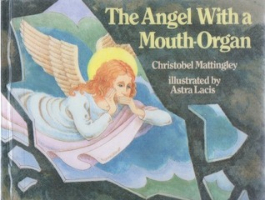
Title
The Angel with a Mouth-Organ
Author
Christobel Mattingley
Illustrators
Astra Lacis
Publisher, Date
Hodder & Stoughton, 1985
Curriculum Codes
AC9E5LA01, AC9E5LA02, AC9E5LA03 , AC9E5LE01, AC9E5LE02, AC9E5LE03, AC9E5LE04, AC9E5LE05, AC9HS5K07, AC9AVA6E01, AC9HP6P01AC9E5LA01, AC9E5LA02, AC9E5LA03 , AC9E5LE01, AC9E5LE02, AC9E5LE03, AC9E5LE04, AC9E5LE05, AC9HS5K07, AC9AVA6E01, AC9HP6P01, AC9HP6P04, AC9HP6P06, AC9HP6P10, AC9E6LA01, AC9E6LA02, AC9E6LA03, AC9E6LE01, AC9E6LE02, AC9E6LE03, AC9E6LE04, AC9E6LE05
ISBN
0340384441
Add to Favourites
-
Subjects
- Bravery
- Courage
- Death
- Families
- Fathers
- Historical fiction
- Loss
- Refugees
- Resilience
- Soldiers
- Survival
- War
- WW2
-
Annotation
The endpapers prepare the reader for this picture-story book about a family of refugees displaced by war. The landscape and story are nonspecific and therefore universal. A desolate, damaged landscape appears across which individuals’ troop, some carrying their belongings, a lucky few riding in wagons. There are deep holes in the ground, unexploded weapons and tangled barbed wire. It is a universal refugee story aimed at mature readers due to its subject, length and figurative language specific to war. For Astrid Lacis, the illustrator, this refugee experience is a familiar one as her family survived World War 2 and came to Australia as refugees.
The rich descriptive details and universal human struggles during war times provide a memorable read aloud sharing experience. Mattingley’s vivid imagery brings the story alive, for example, ‘out of the clouds the planes came, with noise like thunder and flashes like lightning. The houses and the haystacks were like poppies, bursting out of their buds into glowing gold and orange. The church spire and the chimneys like spikes of scarlet salvia.’ Accompanying illustrations are realistic, predominantly warm-coloured and rendered with detailed line that conveys the ravages of war.
Because the story is told from the perspective of the mother recalling her refugee experience, the realities of war are reported rather than dwelt upon. Readers then consider the impact of war at their particular level of understanding. For example, the story reports, but does not dwell on, the deaths of both baby and grandmother. The young narrator reveals moving refugee camps seven times, and her birthdays and Christmases were devoid of presents and parties. When father is seconded to the military and the family moves between multiple refugee camps, this is reported with minimal detail.
Moving through the countryside, the two sisters sing to console themselves and others. They sing the tunes their father used to play on his mouth organ. This brings a satisfying conclusion as the father returns, having found his family through tracking the girls’ songs. He brings with him 'the angel with the mouth organ', a beautiful, but broken glass angel found in the ruins of a church. Now each year the family puts the angel atop their Christmas tree and retells the story of the angel and the family reunion.
‘The Angel with the Mouth-Organ’ was shortlisted in the CBC Book of the Years Awards — Picture Book of the Year in 1985.
-
Teaching Resources
- The Canberra Times 4 Dec 1986 ‘Writer envisions the world through the eyes of her children: A childhood that endures’ by Keith Scott who writes about Christobel Mattingley’s books and her childhood https://trove.nla.gov.au/newspaper/article/130632584?searchTerm=The%20Angel%20with%20a%20Mouth-Organ%20by%20christobel%20mattingley
- NSW Department of Education 7 Jul 2016 Astra Lacis, Illustrator, shows and talks about her artwork created for The School Magazine while also talking about its history and legacy, Youtube presentation https://www.youtube.com/watch?v=XJ1x1pfs5So
- Christobel Mattingley Author’s Official Site provides biographical information and the inspiration for some of her stories for young people https://christobelmattingley.wordpress.com/about/
- Bookbird: a Journal of International Children’s Literature, vol 59, no 3, 2021, pp74-79 and ‘Christobel Mattingley, 1931-2019: Birthday Letters, a Personal Tribute’ by Melanie Duckworth https://muse.jhu.edu/article/800191/pdf
- Better Reading Review 7 June 2019, ‘Christobel Mattingley, Iconic Australian Children’s Author, Passes Away at Age 87’ https://www.betterreading.com.au/kids-ya/christobel-mattingley-iconic-australian-childrens-author-passes-away-at-age-87/
